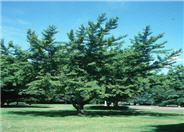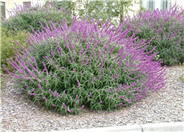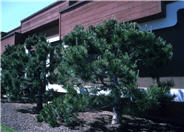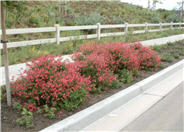
Common name:Ginkgo Tree, Maidenhair Tree
Botanical name:Ginkgo biloba
The Ginko biloba, with its distinct fan-shaped leaves, initially grows with a pyramidal habit, but later becomes wide-spreading. It is slow growing. Leaves turn golden yellow in the fall. Dropping fruit can be a nuisance but you can purchase a male plant to avoid the fruit. Ginkgo can also be used as bonsai. It is generally not bothered by insects or disease.

Common name:Mexican Bush Sage, Velvet Sage
Botanical name:Salvia leucantha
The Mexican Sage is a bushy shrub that grows 3'-4' tall and wide. It has hairy white stems, gray green leaves and velvet-like purple flower spikes that bloom summer through fall. This shrub tolerates sun, light shade, little water, and is hardy to 15 degrees F. The Mexican Sage is drought tolerant and attracts hummingbirds. -Cornflower Farms

Common name:Japanese Black Pine
Botanical name:Pinus thunbergii
This variety of Pine is both rigid and twisted, with needles of 3"-4". It has an irregular shape, and the short, contorted branches produce a canopy shaped tree. The buds are white, and the cones are egg -shaped and without prickles. Pines are highly combustible plants.

Common name:Red Star Autumn Sage
Botanical name:Salvia greggii 'Red Star'
This shrub will grow 1'-4' tall and 1'-4' wide. It has glossy green leaves with red flowers that bloom from fall to spring.

Common name:Rosemary
Botanical name:Rosmarinus officinalis
Rosemary is hardy in full sun areas where winter temperatures do not drop below 10 degrees F. They can be grown in a clay pot with well-drained, porous soil in bright indoor light, and will also flourish on the backporch in spring, summer and fall. Its beautiful, slowly trailing stems and shiny slender leaves are perfect for showing off the small, light blue flowers that blossom in the summer. -Holland WIldflower Farm
| Designer: | Organic Shaped Pavers |
Photographer: GardenSoft |
Soils and Compost:
Practice grass-cycling by leaving short grass clippings on lawns after mowing, so that nutrients and organic matter are returned to the soil.
Water Saving Tip:
Check the soil's moisture level before watering.
You can reduce your water use 20-50% by regularly checking the soil before watering.
Integrated Pest Management:
Remove irrigation water and fertilizer from areas where you don't want weeds to grow.

